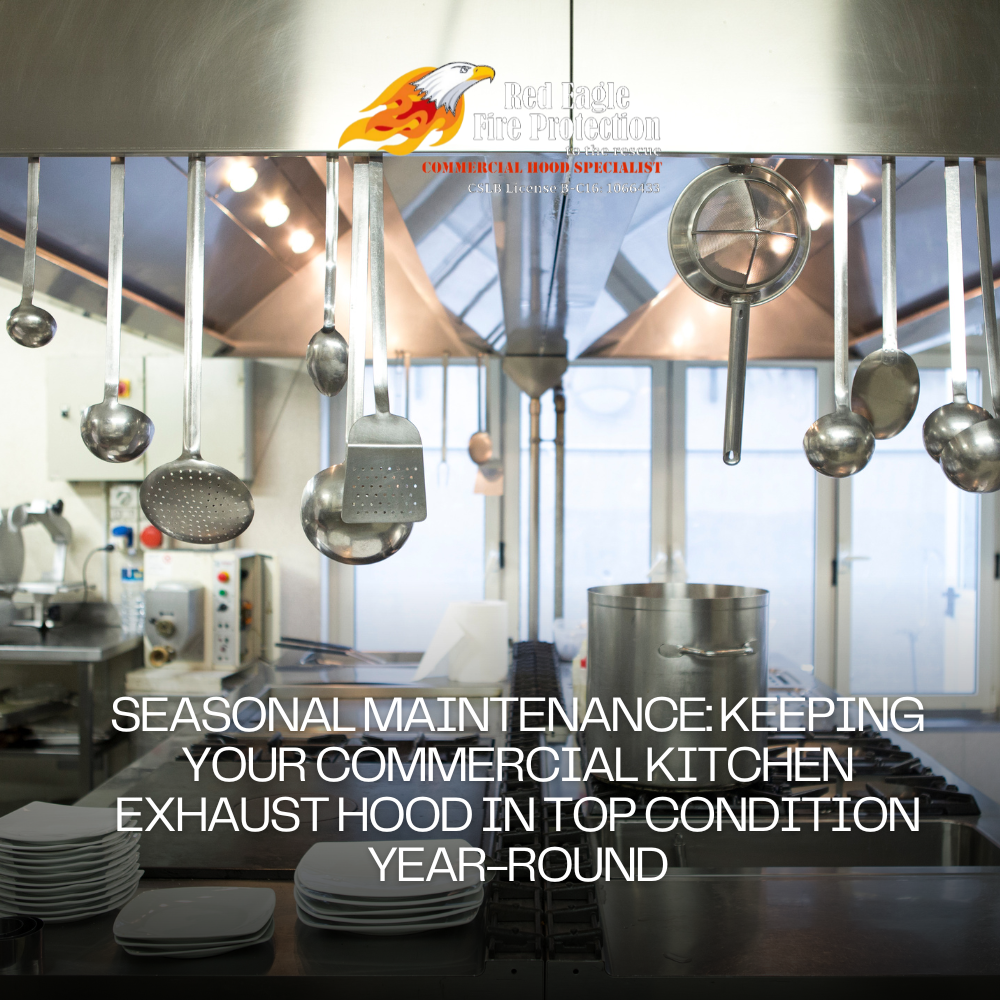Maintaining a commercial kitchen exhaust hood cleaning is essential for ensuring a safe, clean, and efficient kitchen environment. While daily and weekly cleanings are critical, incorporating seasonal maintenance into your routine ensures that your exhaust hood remains in top condition throughout the year. This comprehensive approach helps prevent unexpected breakdowns, ensures compliance with health and safety regulations, and extends the lifespan of your equipment. Here, we outline essential seasonal maintenance tasks for keeping your commercial kitchen exhaust hood in optimal condition year-round.
Spring Maintenance
1. Deep Clean the Ductwork Spring is an excellent time to perform a thorough cleaning of the ductwork. Grease and debris can build up over time, reducing airflow efficiency and increasing fire risk. Schedule a professional duct cleaning service to ensure that the entire system is free from obstructions and buildup.
2. Inspect and Replace Filters Spring is also a good time to inspect the condition of your grease filters. Replace any worn or damaged filters to ensure optimal performance. Clean reusable filters thoroughly by soaking them in a degreasing solution and scrubbing away any accumulated grease.
3. Test the Exhaust Fan and Motor Ensure that the exhaust fan and motor are operating efficiently. Listen for any unusual noises that might indicate wear or damage. Lubricate the motor bearings if necessary and check for any loose connections or parts that might need tightening or replacement.
Summer Maintenance
1. Check for Signs of Wear and Tear The summer months can be particularly demanding on commercial kitchens due to higher volumes of customers. Inspect the entire exhaust hood system for signs of wear and tear, including cracks, rust, and other damage. Address any issues promptly to prevent them from becoming more serious problems.
2. Clean Exterior Surfaces High temperatures and humidity can contribute to grease and grime buildup on exterior surfaces. Use a commercial-grade degreaser to clean all accessible surfaces of the exhaust hood, including the exterior and any surrounding cabinetry or walls.
3. Monitor Airflow Efficiency Ensure that the exhaust system maintains optimal airflow. Reduced airflow can indicate blockages or inefficiencies within the system. Test the airflow and address any issues to maintain proper ventilation and kitchen safety.
Fall Maintenance
1. Inspect and Clean the Exhaust Hood Canopy Fall is a good time to perform a comprehensive inspection and cleaning of the exhaust hood canopy. Remove any accumulated grease and debris that may have been missed during routine cleanings. Pay special attention to corners and hard-to-reach areas.
2. Evaluate Fire Suppression System Check the fire suppression system integrated with your exhaust hood to ensure it is in good working order. Replace any expired fire suppressant canisters and test the system to ensure it activates correctly in the event of a fire.
3. Prepare for Increased Winter Usage With the approach of the holiday season, many commercial kitchens experience increased usage. Ensure that your exhaust hood system is prepared for higher volumes of cooking by conducting a thorough maintenance check. Replace any components showing signs of wear and ensure that the system operates efficiently.
Winter Maintenance
1. Perform a Comprehensive Inspection Winter is an ideal time to perform a comprehensive inspection of the entire exhaust hood system. Check all components, including the fan, motor, ductwork, and filters, for any signs of damage or wear. Address any issues immediately to prevent breakdowns during the busy holiday season.
2. Clean and Polish Stainless Steel Surfaces Winter maintenance should include a thorough cleaning and polishing of all stainless steel surfaces. Use a stainless steel cleaner and a soft cloth to remove fingerprints, smudges, and grease buildup, leaving your exhaust hood looking pristine.
3. Schedule Professional Maintenance Consider scheduling a professional maintenance service to perform a detailed inspection and cleaning of your exhaust hood system. Professionals can identify and address issues that may not be apparent during routine cleanings, ensuring that your system operates at peak efficiency.
Best Practices for Seasonal Maintenance
1. Keep a Maintenance Log Maintain a detailed log of all maintenance activities, including the date, tasks performed, and any issues identified. This documentation helps track the condition of your exhaust hood system and ensures that all necessary maintenance tasks are completed on schedule.
2. Train Staff on Maintenance Procedures Ensure that all kitchen staff are trained on proper maintenance procedures and understand the importance of regular cleaning and inspections. Assign specific tasks to team members to ensure consistency and accountability.
3. Follow Manufacturer Guidelines Adhere to the manufacturer’s maintenance guidelines for your specific exhaust hood model. This ensures that you use the correct cleaning methods and products and that your system remains under warranty.
4. Prioritize Safety Always prioritize safety during maintenance activities. Use appropriate personal protective equipment (PPE), such as gloves and eye protection, when handling cleaning chemicals and performing maintenance tasks.
By incorporating seasonal maintenance into your routine, you can keep your commercial kitchen exhaust hood cleaning in top condition year-round. This proactive approach ensures a safe, efficient, and compliant kitchen environment, allowing you to focus on delivering excellent food and service to your customers.
READ MORE:
Weekly Deep Cleaning Tips for Maintaining Your Kitchen Exhaust Hood
Creating an Effective Kitchen Exhaust Hood Cleaning Schedule: Daily, Weekly, and Seasonal

